Rima Merriman, a Palestinian American living in Ramallah, wrote this series, “Portraits of Palestinian Resistance”, telling the stories of the four Palestinians killed and one of the 57 wounded in Ramallah on 24 May 2006, as they struggled to protect a Palestinian activist and political prisoner from an Israeli undercover unit.
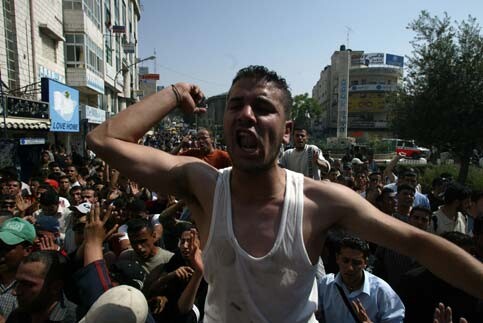
Palestinian men at Alsa’a Square, a few hundred yards from Al Manarah Circle. (Al-Quds Newspaper)
Palestinian resistance to the occupation comes in many shapes and forms, some of which involves armed resistance undertaken by organized groups with various ideologies. These groups are composed of barely trained young men who pit their meager and crude resources against one of the best trained and best equipped military body in the world, the Israeli Occupation Forces. Of the 76 Israeli soldiers who died in 2005, only six were killed as a result of Palestinian attacks. The rest died of illness or accidents. Thirty of them committed suicide.
The imbalance in the resources between the two sides of the conflict predictably yields a steady mowing down on the part of the Israelis of one young Palestinian martyr after another. Most Palestinian deaths, however, are of civilians (and children) simply going about their daily lives, getting caught up in Israeli ground and air attacks, Israeli indiscriminate fire and Israeli raids.
Israel’s control of and entrenchment in the West Bank and Gaza Strip, its continual attempts to stamp out Palestinian resistance to the occupation at any cost, relies heavily on intelligence gathered by Shabak, the 5,000-strong Internal General Security Service of Israel, whose motto is “Defender who shall not be seen”.
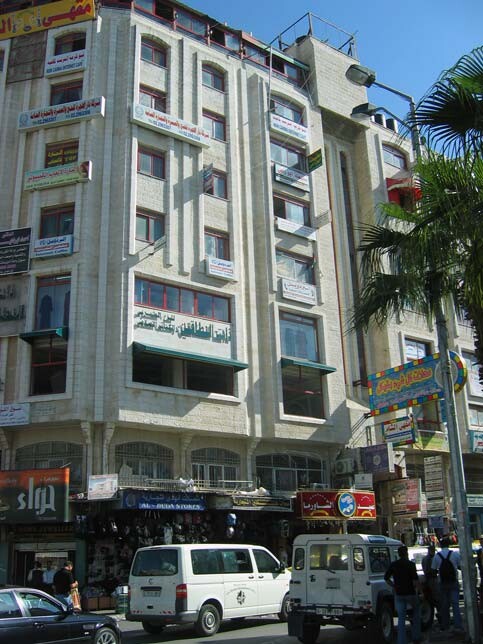
Lulua Building, which houses the Internet Café on the sixth floor. (Rima Merriman)
With a cadre of well-trained, Arabic-speaking Israeli informants who are indistinguishable physically from the Palestinian population, Shabak has little problem gathering intelligence on a people whose every movement is regulated by hundreds of check points and by total Israeli control on their borders. These infiltrators prey on Arab innate hospitality and friendliness. The Palestinians call them “musta’ribeen”, i.e., “those who appear to be Arabs”. Palestinians are not surprised when someone, somewhere comes up to them and says: Got you!
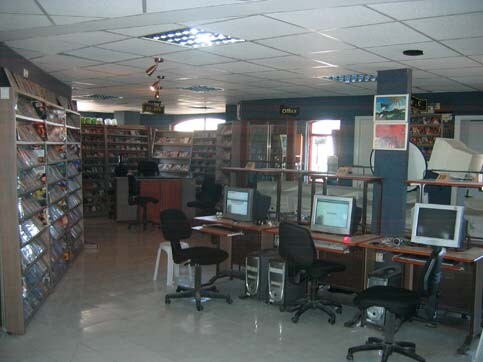
The interior of the Internet Café. (Rima Merriman)
On May 24th at about 2:30 in the afternoon, three musta’ribeen walked into the Al Karmi Internet Café on the sixth floor of the Lu’lu’a (meaning “pearl”) building on Al Manara Circle in downtown Ramallah. They went up to the snack bar and ordered juice and then coffee. Their quarry, Mohammad Hamed Al Shobaki, leader of Islamic Jihad in Qalqilya, was at one of the computers of the Café.
In the meantime, a white van with tinted windows and a Palestinian license plate came barreling down the street against traffic, parked at the entrance of the building and disgorged 10-15 Israeli soldiers in full gear, four of whom had on black clothes and black caps. They stormed up the stairs and into the Café, herded everybody into a corner and arrested Al Shobaki. They also “arrested” the three musta’ribeen and covered all four with the black garb.
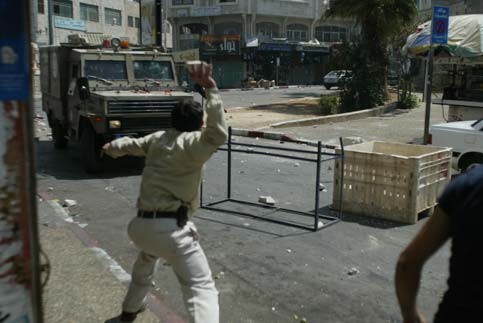
Palestinian man trying to prevent Israeli Jeeps from getting to Al Manarah Circle. (Al-Quds Newspaper)
The outcry on the street was immediate and spontaneous. Palestinian youth who were in the area started gathering stones and rocks and whatever else they could get their hands on. Someone drove the white van away and was stopped by a hail of stones. The van was promptly set on fire, as the driver, shouting that he was a Palestinian, jumped out.

Palestinian men running towards Lulua Building. (Al-Quds Newspaper)
Soon, Israeli reinforcements arrived on the scene, though not without being challenged on the way by crowds of angry Palestinian youth, who tried to block their passage. A handful of young Palestinian men who had weapons used them in the attempt. To get their quarry and retreat, it took the Israelis more than two hours, fifteen Israeli armored vehicles, two helicopters and an arsenal of weapons that included tear gas, sound bombs, rubber and specifically designed live bullets that explode inside the victim’s body causing severe harm and tissue damage (called dom-dom bullets). Four young Palestinians were shot dead and scores were wounded. Israeli live fire was reported to be indiscriminate.
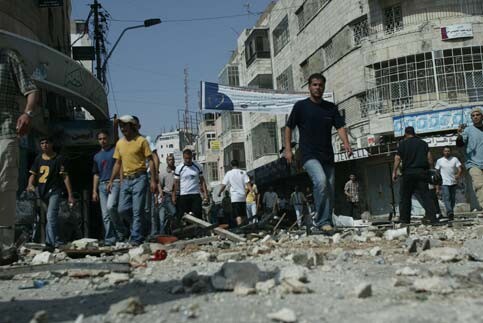
Rocks, glass bottles and stones by the Luluah Building (Al-Quds Newspaper)
For the Israelis, it all must have seemed like a minor inconvenience, easily brushed off, with no loss of life on their well-armored parts. The Palestinian security forces, who are hugely out gunned (they are allowed nominal amounts of ammunition) and outnumbered by the Israeli forces, understand in military fashion the terrible consequences of any engagement they might choose to conduct with their occupiers. Their orders are always to withdraw from any confrontation.
But for the young men who spontaneously rushed to defend Palestinian freedom on May 24th, there was no question of looking on helplessly as the Israelis marched into their town in broad daylight to pluck off one of their leaders. The incident was a battle that showed off their mettle, the battle, as they are now calling it, of endurance and defiance.

Jafar Khaled Betilla, one of the martyrs. (Al-Quds Newspaper)
Already, the events are slipping into legend, the courage and numbers of the participants expanding with every telling. The men and boys proudly recall how fearlessly they fought, what damage they inflicted. They admire the courage of their fallen comrades whom they commemorate with posters and slogans that convey the spirit of their resistance: “The National Liberation Movement ‘Fateh’ does not forget the blood of its men. Tomorrow, giant-like men will avenge me.” So says the legend on Milad Atallah Abu Al Arayes’s commemoration poster. He is one of the four young Palestinian men who lost their lives at Al Manarah on May 24th.
Rima Merriman is a Palestinian-American living in Ramallah in the occupied West Bank.
Related Links




